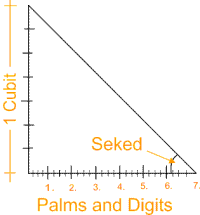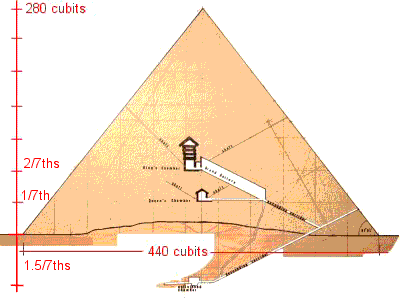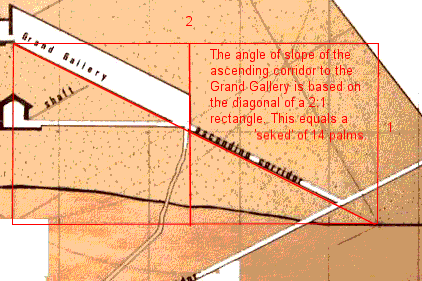|
Sekeds and the Geometry
of the Great Pyramid
by David Furlong
A consideration of the Sekeds used in the construction of the Great Pyramid
Discussion
This article looks at the possible sekeds that were used in the construction of the Great Pyramid. It attempts to show that much of the internal design of the Khufu's pyramid can be explained in terms of the seked.
Sekeds in the design of pyramids
For information on the use of the seked in
the design of pyramids please click here.
The seked is based on the Ancient Egyptian
measures of the Royal Cubit, the palm or hand and the digit.
The relationship of these measures is as follows:
1 cubit = 7
palms
1 palm = 4 digits
The seked is effectively the way the Ancient Egyptians measured angles of slope and as such we would expect to find their use in the construction of any pyramid.
 The seked was expressed as a unit ratio of the Royal Cubit, such as 5 palms and 2 digits, which is the seked angle of the Great Pyramid of Giza. The angular equivalent is 51°- 51' . The seked was expressed as a unit ratio of the Royal Cubit, such as 5 palms and 2 digits, which is the seked angle of the Great Pyramid of Giza. The angular equivalent is 51°- 51' .
Examining the ratios within the pyramid of king Khufu or Cheops as he was known to the Greeks, allows us to work out the different sekeds that were used in it's construction.
The Basic Measures and Ratios of the Great Pyramid
Base sides average = 230.364m = 440 Royal Cubits
Height = 146.59m = 280 Royal Cubits
Angle of slope = 51° - 51' = Seked 5 palms and 2 digits
(decimally expressed as 5.5)
 Fig1.
Fig1.
The Position of the King's and Queen's Chambers
In Fig 1. The position of the King's Chamber is approximately 2/7ths the height of the pyramid, whilst the Queen's chamber is set at 1/7th the height or 40 cubits above the base level, making the King's Chamber 80 cubits above base.
These ratios fit with a broad design using the mathematical constraints of a seked. However as Petrie pointed out the precise measures of the height above base for the King's and Queen's chamber show slight variance on these ratios to incorporate a further refinement in the design. According to Petrie the heights above base are as follows:
Height of Pyramid = 5776 inches ± 7inches
Height of King's Chamber = 1691.4" to 1693.7" ± .6
Height of Queen's Chamber = 834.4" ± .3
From these figures it is clear that there is just over a 43 inch or 2 cubit difference between the theoretical and actual height of the King's chamber above base on a 2/7 ratio basis. The most probable reason, which Petrie proposed is that the height of the King's Chamber was established at a level that was 1/2 the triangular area of the cross-section of the pyramid.
The Position of the Subterranean Chamber
Similarly the position of the Subterranean Chamber, sometimes known as "The Pit" is set at 1.5/7ths or 3/14ths the height of the finished pyramid making the floor of the Chamber 60 cubits below base level.
 Fig 2. Fig 2.
The Alignment of the Ascending and Descending Corridors
Fig 2. shows the ascending passageway leading to the Grand Gallery, which is set to an angle of
26°-33'-54"
. This is simply the diagonal of a 2:1 rectangle. Expressed as a seked this would equal 14 palms.
The descending passageway leading to the Subterranean Chamber, is also set to similar angle, yet pointing in the opposite direction; so this too is based on a simple geometric ratio taken as the diagonal of the 2 x 1 rectangle.
The seked of the two Corridors and the Grand Gallery = 14 palms
The alignment of the descending gallery to the hypothetical point where it intersects with the base-line of the pyramid, to complete the diagonal of the square, is fixed by an equilateral triangle, based on the height of the pyramid.
Astronomical Alignment of the Descending Corridor
There have been claims that the ascending and descending corridors are aligned to the stars, particularly Thuban. Bearing in mind the difficulties of aligning such a construction during the night and that the altitude of the star was too high in the sky during the construction, makes these theories unlikely. The Egyptian masons simply cut the angle of the stones on a ratio of 2:1, to form the angle of slope for the ascending and descending passageways.
The precise level of accuracy, perceived by Petrie, when he measured the pyramids, can be achieved by sighting as long as care is taken. The stone columns in Kafre's Valley temple are similarly aligned with extreme precision. These certainly had nothing to do with alignment to the stars.
Internal Shafts
Four internal shafts, sometimes called "ventilation shafts", rise upwards within the body of the pyramid towards the outer casing. Two are found within the Kings' Chamber and two in the Queen's Chamber (see Fig 1.) These shafts point towards the North and the South and are set to different angles. They do not generally have the same level of precision as the visible chambers of the pyramid.
The shaft angles from Petrie's survey are as follows:
King's Chamber Southern Shaft = 45°-13' (mean)
King's Chamber Northern Shaft = 31° (This varies between 30°-43' to 32°-4')
Queen's Chamber Southern Shaft = 37°- 28' (mean)
Queen's Chamber Northern Shaft = 38° - 28' (mean)
The seked angles within this range are:
6 palms 3 digits = 46°- 2' - 30 "
7 palms = 45°
.....
8 palms 3 digit = 38 °- 39' - 35"
9 palms = 37 °- 52' - 30"
.....
11 palms = 32 °- 28' - 16 "
11 palms 1 digit = 31°- 53' - 27"
11 palms 2 digits = 31°- 19' - 43"
11 palms 3 digits = 30°- 47' - 3"
It needs to be appreciated that that measurement of angles within such a confined space is exceptionally difficult and the margins of error within Petrie's survey are likely to greater than he has suggested. If we a assign as seked to each of these internal shafts they would be as follows:
King's Chamber Southern Shaft = 45°-13' = seked 7 palms
King's Chamber Northern Shaft = 31° = probably intended as seked 11 palms
Queen's Chamber Southern Shaft = 37°- 28' = seked 9 palms
Queen's Chamber Northern Shaft = 38° - 28' = seked 8 palms 3 digits
Astronomical Alignments and the Pyramids
There is a current vogue for suggesting that the internal chambers of the Great Pyramid as well as the shafts are aligned to specific stars or constellations.
As I have shown in my article on the astronomical alignment of the Egyptian temples there are many complications in using the stars for precise alignments. Clearly the rising and setting positions could be used for establishing azimuths as long as atmospheric extinction is taken into account. Establishing angles of height above ground level are more problematic because of the rotation of the Earth.
However there is a reasonable argument that some of these shafts could be aligned to astronomical events.
The Southern Alignments:
King's Chamber - Petrie measured this angle as 45°-13'. The middle star of Orion's Belt, which we call Alnilam, has a maximum altitude of 45°-3'. It is possible that the southern shaft of the King's Chamber is aligned to this star. The other possibility is Mintaka, the leading star of the belt, which has an altitude of 45°-30'.
Queen's Chamber - The measured angle here is 37°- 28'. There are no obvious stella fits, however the altitude of the mid-winter Sun is 37°- 23'. This fits almost perfectly with the calculated angle of this shaft. This means that the altitude angle of this shaft could only have been set one or two days on either side of the solstice. The mid-winter solstice does figure in a number of temple alignments and was therefore significant to the Ancient Egyptians.
The Northern Shafts
King's Chamber - according to Petrie the angle range for this shaft varies between
30°-43' to 32°-4'. The star α Draconis or Thuban has an altitude varying between 28°-37'
to 31°-27' as it circles the celestial North Pole, for the assumed construction date of c.2550bc(1). This fit is only approximate but is the most probable for the alignment of this shaft.
Queen's Chamber - the shaft angle is given as 38° - 28'.
Unfortunately there are no stars that fit this altitude. The closest is κ Draconis, which has an altitude of 38° - 57'(2). However if we bring forward the construction time to 2467bc(3) then the altitude of
κ Draconis is a little closer at 38° - 41'. It would seem that this is the most probable fit although still subject to the verification of alignment angle of the shaft and to the dating of pyramid.
Summary
The majority of the internal corridor alignments within the Great Pyramid as well as the position of the different chambers can all be explained in terms of the known geometry of the Ancient Egyptians, which is based upon the use of sekeds to determine angles of slope. The four shafts, whilst conforming to seked interpretation do offer more scope for an astronomical explanation. Their alignments can be summarized as:
King's Chamber: North - α Draconis or Thuban
King's Chamber: South - Alnilam (middle star of Orion's Belt)
Queen's Chamber: North - Midwinter solstice (Maximum altitude of the Sun)
Queen's Chamber: South - κ Draconis
Bibliography:
1. Reading the Past: Mathematics and Measurement, O.A.W. Dilke
British Museum Press 1987
2. Mathematics in the Time of the Pharaohs, Richard Gillings.
Dover (NY) 1972
3. The Pyramids of Egypt, I. E. S. Edwards. Ebury Press 1947
4. The Pyramids and Temples of Gizeh, William Flinders Petrie. Field and Tuer 1883
(This can be read online see: http://www.touregypt.net/petrie/index.htm
5. The Complete Pyramids, Mark Lehner. Thames and Hudson 1997
6. Egyptian Pyramids, Leslie Grinsell John Bellows 1947
Notes:
1. The Complete Pyramids, Mark Lehner. p108
2. This is based on the StarCalc astronomical programme. The Starry Night programme shows a slightly lower altitude of 38°-3.147'
3. Nature Article: November 2002 based on research work of Kate Spence
Other links articles:
Abydos - Temple mysteries
Egyptian Temple Orientation - Astronomical Alignments
Egypt tour : sixteen day tour in January 2008
The Keys to the Temple - Mystery patterns in the British landscape showing pyramid
geometry.
Site Map - List of all David Furlong's articles
|
For further information please write to:
David Furlong
Myrtles, Como Road, Malvern Worcs WR14 2TH
or phone 01684-569105 or 07779789047
Email:
David Furlong |
|





